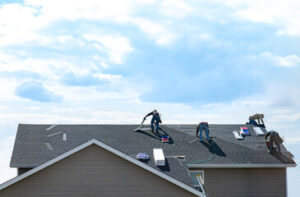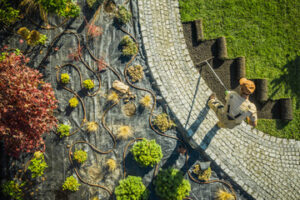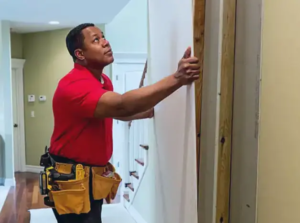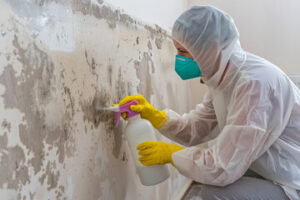A gutter system is essential for keeping water away from your house, preventing soil erosion and basement flooding. Taking care of these simple but crucial systems prevents costly damage to your home, including foundational cracking and erosion, garden sand & dirt spreading in the driveway, and pest infestations.
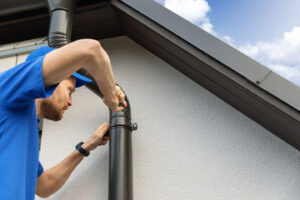
Charleston Gutter Solutions components include: gutter channels, downspouts, gutter elbows, and end caps.
Gutters are a critical part of any building’s water management system, taking rainwater away from the structure to prevent erosion and other water-related issues. They are installed along the edge of roofs and channel rainwater down into downspouts and into an underground drainage system. This ensures that rainwater does not pool around the foundation of a building and reduces moisture problems like mold, mildew, and wood rot. It also protects a building’s exterior, walls, windows, and foundation from soil erosion and water damage. A gutter should be properly sized and positioned so that it does not clog or overflow during rainfall, while maintaining the correct slope to disperse water evenly.
Gutter systems are available in a range of materials, including rust-resistant aluminum, vinyl, copper, and stainless steel. They can be customized with downspout elbows and trough extensions to provide a more decorative finish. A variety of downspout styles are also available, from round to square, though square downspouts are more popular for their sleek look. Downspout extensions are often used to redirect the flow of water, as they are effective at reducing blockages and allow for better drainage of large quantities of rainwater.
A proper gutter system should be sized to match the size of a home’s roof, and its downspouts should be positioned at an appropriate distance from the foundation to keep the ground from flooding and causing structural damage. The system should also be inspected on a regular basis to prevent clogs and other damage. It is best to clean the gutters twice a year, in the spring and fall, to remove twigs, leaves, and other debris before they become clogged.
In addition to preventing the buildup of debris, the right gutter system can facilitate rainwater and snow melt collection. This is an increasingly popular way to promote sustainability, transforming wasted precipitation into a valuable resource for indoor and outdoor gardening and household needs. A few simple modifications to existing gutter systems can make this possible, including installing heated gutter guards and inspecting the system before winter weather arrives. This is a much less time-consuming task than dealing with ice dams and other water damage caused by improper drainage.
Foundation Protection
The foundation of a house is what everything else rests on, and damage to it can result in major structural problems for the entire building. The primary threat to a home’s foundation is excessive moisture, and gutters play an important role in protecting it. Gutters direct rainwater away from the foundation, roof, and walls to prevent water damage.
Water-saturated soil expands and exerts pressure against the foundation, which can cause cracking and shifting over time. Gutter systems are designed to direct rainwater directly to an underground drain or downspout extension to prevent soil erosion and the resulting pressure against the foundation.
A functional gutter system is a great investment for homeowners. Unlike expensive repairs, it can protect the integrity of a home’s foundation and add value to it. In addition, gutters can also prevent moisture damage to the basement, drywall, flooring, and stored belongings.
Gutters and downspouts are essential in any home to minimize damage from water and soil erosion. A gutter system is made up of many different components that work together to efficiently drain rainwater and prevent the accumulation of standing water. These components include gutters, downspouts, end caps, miters, and outlet tubes.
Ideally, a gutter system should be sloped at an angle so that water will flow into a downspout instead of over the top of it. Downspouts are then connected to an underground drain or a downspout extension that carries water away from the foundation and soil.
End caps cover the ends of downspouts to avoid clogs and keep out debris. They are available in a variety of styles to match the style of the gutter. Miters are curved pieces of metal that join two sections of gutter together to provide an even join and reduce the possibility of leaks. Gutter downspout extensions are long pieces of pipe that extend the length of a downspout to allow for more distance from the foundation and to avoid problems with expansive or erosion-prone soil.
Outlet tubes are rectangular tubes that fit into a downspout to maximize drainage capacity. These tubes are available in various sizes to accommodate different amounts of rainwater.
Pest Control
Gutters are high up and generally undisturbed, making them attractive spots for pests to build nests and access your home. The damp, decaying debris inside clogged gutters can also act like a beacon for pests in search of food, water and shelter. Preventing pests in gutters requires preventative strategies, as well as regular cleaning and maintenance.
Rodents are an especially big problem in gutters, as they can chew through the troughs and downspouts to craft nests or climb onto your roof. Their droppings, urine, and feces can stain the gutters, as well as create health hazards for your family and pets. Plus, their chewing can also lead to rust or warping of the gutters and can compromise the roofing infrastructure.
Birds, squirrels and chipmunks are other common critters that can invade your gutter system. They use the twigs and branches in a gutter to craft their nests, which can be a real nuisance for homeowners and may even interfere with the structure of your home. Stinging insects, such as bees and wasps, also make their homes in the tight spaces of a gutter, where they can sting anyone that comes near.
Other gutter-dwelling pests include mosquitoes, termites and ants. Standing water in a clogged gutter provides an ideal breeding ground for mosquitoes, which can cause diseases such as West Nile Virus. The rotting debris in a clogged gutter can also attract termites and other wood-destroying pests.
A major infestation of pests can be hard to deal with, as they require professional removal and treatment of the surrounding area. In addition, the weight of a pest nest can damage the gutters and cause them to bend and pull away from the house.
Gutter guards can help protect your gutters from pest invasions. When properly installed, they prevent troughs and downspouts from becoming clogged with debris. Regular maintenance and cleaning can also help reduce the risk of pest infestations, as well as other problems such as leaks. Other effective pest prevention strategies can include natural deterrents, such as certain plants and essential oils. These can be a great choice for environmentally-conscious homeowners who want to keep their property free of pests without using harsh chemicals or inhumane methods.
Aesthetics
A gutter is more than a functional component; it can serve to accentuate your home’s architectural style. A visually appealing gutter protects your property while adding to its beauty and curb appeal. With a wealth of design options and accessories available, homeowners can transform their gutters into essential components of their home’s exterior aesthetic.
Aesthetics in a gutter system begin with the choice of gutter material and design. Gutter materials come in a variety of finishes, allowing homeowners to choose a color that perfectly complements their exterior. Coordinating gutter colors with fascia boards and eaves creates an integrated and balanced appearance. Incorporating other decorative elements into your gutter design can also help enhance the aesthetic. Decorative brackets, rain chains, and downspout covers are all simple ways to add an element of visual interest to your gutter system.
Regardless of the aesthetic choice, choosing a gutter material that offers durability and corrosion resistance is vital. Gutters that are poorly constructed can easily degrade over time, resulting in damage to your home and costly repairs. Gutter materials such as copper, steel, and aluminum can resist corrosion better than gutters made of wood or vinyl.
The aesthetic in a gutter system goes beyond simply matching the color of your home’s siding and trimming. Using the right design elements and accessories can help your gutters become a striking focal point of your home’s exterior, elevating their functionality to a new level of sophistication.
A gutter can be a focal point of your home’s exterior, whether it is ornately decorated with half-round designs or sleek and modern K-style gutters. By carefully considering the architectural style of your property, you can use gutters to highlight certain features and create a cohesive overall design.
